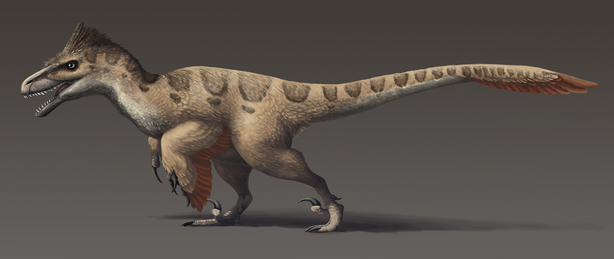A New Superpredator: Dakotaraptor
The monster itself
The carnivorous dinosaurs, or Theropods, have a great variety of extremely well adapted predators. The earliest Theropods were largely fast running, frail creatures that acted like scaly coyotes, but within 20 million years they had diversified into a myriad of forms from more and more efficient small predators to elephant sized apex predators. In the cretaceous, the third and final period of the age of dinosaurs, the Dromaeosaurids filled a number of specialized predatory roles. These famous dinosaurs are better known as “Raptors” after the suffix in many of their names. This term actually has its roots in the latin word rapere “thief” or “bandit”. The Dromaeosaurids are divided into several subgroups, but all share some common traits. They are lightly built predatory dinosaurs with thin bones and stiff tails, designed to counterbalance the head and arms while running. Their arms have flexible wrists and other features that show a tendency towards flight, which would be fully developed in their close relatives; the birds. Recent evidence suggest that the majority of species were fully feathered, which served as ornamentation and insulation in northern habitats Most notably, all possess a large, hook shaped claw on their inner toe, which enabled them to kill prey much larger than another similarly sized dinosaur could have. The preferred method for using it seems to have been to make deep gouges in the sides of large prey and then back off to wait for it to bleed to death. However, not all Dromaeosaurids conformed to this niche as big game hunters. Crow sized, winged species such as Microraptor scrabbled through the trees and flew after insects in prehistoric China. Very lightly built and intelligent species related to the Troodon prowled the forest floor capturing mice, lizards, and baby dinosaurs. Medium sized species ranging from the wolf sized Velociraptor to the human height Deinonychus appear to have hunted in large packs like modern wolves, targeting prey of a variety of sizes. In addition to these well studied dromaeosaurid niches, there a few giant raptors about which little is known.
Giant raptors appear to be two primitive offshoots of the Dromaeosauridae. Achillobator, a 19 foot long species from Mongolia, and Utahraptor, a 23 foot long species from (you guessed it) Utah are closely related and both from the early Cretaceous (approx 90 million years ago). Austroraptor is a similarly sized species from South America that is related to a different family of Dromaeosaurids altogether and lived during the middle Cretaceous (approx 75 million years ago). All of them were very active predators, who lived alongside and hunted prey up to five times their weight, such as the long necked Sauropods or semi-bipedal Hadrosaurids. It was thought that all giant raptors went extinct before the end of the Cretaceous 66 million years ago, but the discovery of the new species Dakotaraptor has completely changed this.
Building off of the naming system used for Utahraptor, Dakotaraptor’s home state is obvious. The fossils of this species were actually first found 5 years ago, but only on October 30th of 2015 was the paper unveiling it completed. Much about Dakotaraptor is still unknown, but it does have some unique traits that distinguish it already. Firstly, its arm to leg proportions are almost identical to those of Deinonychus, which indicates that it may be a giant relative of this species and its kin, rather than a continuation of the Utahraptor lineage. However, the limbs are the only complete part of this dinosaur yet found, so it is not possible to tell exactly how Dakotaraptor is placed in the family tree just yet. Additionally, the two specimens that exist are clearly different in size and build, one being noticeably larger and tougher than the other, despite both being adults. Possible hypotheses are that they represent different breeds, or the smaller one is stunted, or that one represents male and the other female. Researchers favor the sexual dimorphism theory, because 50% of fossils are of males and 50% of females, so it is equally likely to find specimens of either gender. However, they have not decided which gender is which form. The final distinguishing feature is the quill knobs present on the arm bones of Dakotaraptor. These anchor large feathers, which indicates that Dakotaraptor had a wingful of feathers on its arms. This does not mean that it could fly, but instead that it used those feathers as a display feature or possible as a means of insulating the nest or young. These features make Dakotaraptor a very interesting dinosaur, but what is even more interesting is where it lived and when.
Dakotaraptor was found in Harding County, South Dakota. This county is in the upper western corner of South Dakota, and the exact right place to find dinosaur fossils from the very latest Cretaceous. In fact, Dakotaraptor was found in the most famous late Cretaceous rock formation of all: Hell Creek. Hell Creek represents the exact end of the era of the Dinosaurs, the mesozoic. It is placed 66 million years ago, just before and exactly at the time when a combination of a massive meteor, a supervolcano, and the absurd levels of pollution and greenhouse effect that followed in their wake killed 75% of all life on Earth. In fact, some outcroppings actually demonstrate the thin line of rock built from ash and iridium where the mesozoic ends and the cenozoic, the age of Mammals, begins. The environment was a temperate, rainy river delta, like the Mississippi delta in Louisiana today. The steady, gentle deposition of fine silt and soil over and wide area makes this type of environment excellent for fossilization, and the ecological prosperity drew prehistoric animals of all types into to make a biodiverse paradise. Except in this case the initial appearance of paradise bellies the presence of some of the most dangerous of all dinosaurs. In the very latest Cretaceous North American dinosaur groups of all kinds reached the largest sizes in their evolutionary history. Hell Creek is the best place to find Tyrannosaurus Rex and Triceratops, each more dangerous than any modern animal, as well as Ankylosaurus, the largest armor plated dinosaur, Anatotitan, one of the largest Hadrosaurids, and Pachycephalosaurus, the largest dome-skulled dinosaur. Even the pterosaurs were large in Hell Creek, its skies were ruled by the giraffe sized Quetzalcoatlus, appropriately named after the Aztec sky god. In this ecosystem, Dakotaraptor fills the gap as a medium sized predator. Paleontologists have always thought that there should be a medium sized predator in this ecosystem, because most dinosaur ecosystems had one. They theorized that juvenile Tyrannosaurus Rex filled this role, or that the lightly built juveniles were actually a different species called Nanotyrannus. While it’s very likely that one of these theories is also true, there is now conclusive evidence that Dakotaraptor existed to fill that role. For paleontologists and other paleontology enthusiasts this is very exciting, as Hell Creek is a rightly famous formation and this new dinosaur completes what is already one of the most complete prehistoric ecosystems yet studied.
Additional reading:
News Article:
Scientific Paper:
https://kuscholarworks.ku.edu/bitstream/handle/1808/18764/DePalma%2014.pdf?sequence=3










